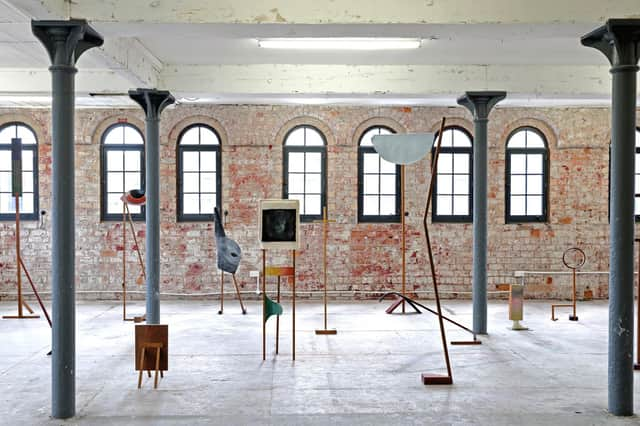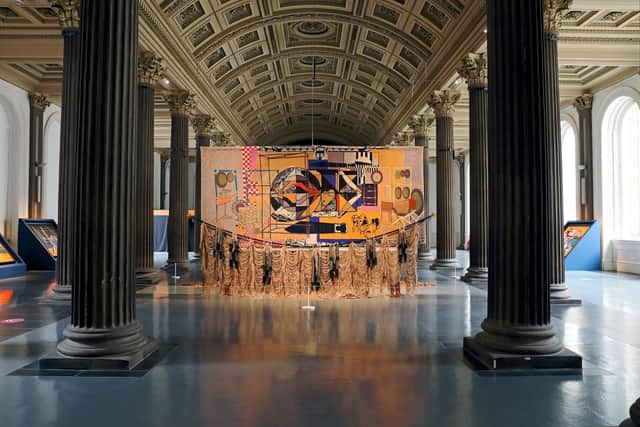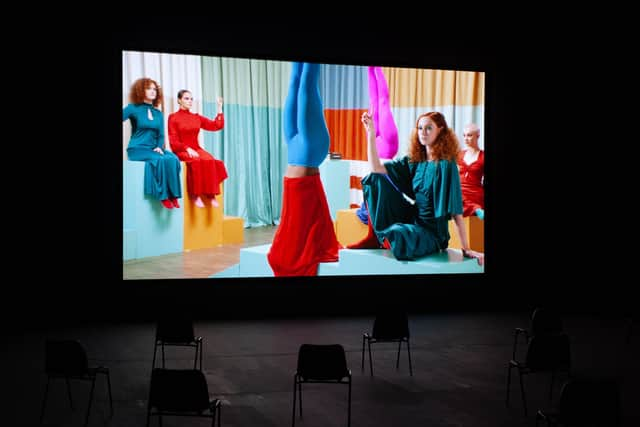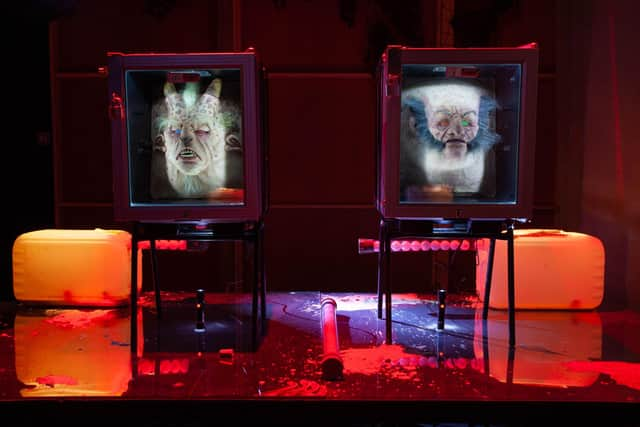Art review: Glasgow International, various venues, Glasgow


Last year’s Glasgow International was cancelled at the eleventh hour when the pandemic hit. This year, it feels like one of the first events off the starting blocks as lockdown lifts. All credit goes to Richard Parry and his team for mounting the usual ambitious city-wide programme in times of changing Covid tiers and general uncertainty.
GI has always sought to exploit the magic which can happen between art and evocative found spaces. There might be a bit less of this in the GI commissions for 2021, for obvious reasons, but Yuko Mohri’s ghostly self-playing piano (***) and the quiet congregation of wooden sculptures by Brazilian artist Ana Mazzei (****) both seem tailor-made for the atmospheric interior of the Pipe Factory.
Advertisement
Hide AdThe Barrowland Ballroom is so rich in association it barely needs art work at all, and Duncan Campbell’s film O Joan, no… (a work from 2006, brought in when his new commission had to be postponed due to technical issues, ***) seems to echo the ghosts which are already there with its disembodied lights, moans and sighs. Meanwhile, France-Lise McGurn’s new installation for the balcony in Kelvingrove (****) plays on contrasts – her sleek, contemporary figures entering to dialogue with the architecture and its historical art collection.


Meanwhile, Canadian artist Nirbhai (Nep) Sidhu, in his first European show, turns the ground floor gallery at GoMA into something which feels a bit like a temple. In An Immeasurable Melody (Medicine for a Nightmare) (****), three monumental tapestries, flanked by smaller ones on each side, draw us in to an atmosphere steeped in Sikh spirituality and history, with a particular focus on the role of sound.
The non-Sikh viewer might not always grasp the full meanings of the images, or the rather hypnotic music, but one is left in no doubt of their profound significance. A meditative film, Black (W)hole, by Sidhu and Maikoiyo Alley-Barnes, acts as a partial cipher. It feels like a glimpse into a culture and faith different to one’s own in which deep wells of meaning lie out of reach, but to which one responds with respect and fascination.
In this light of this show, Georgina Starr’s 45-minute esoteric film at Tramway feels stylised and superficial. Quarantaine (***) – incidentally, nothing to do with the pandemic – is about two young women and their initiation into a clandestine institution, possibly a cult.
It’s weighed down by copious amounts of styling, while leavened by moments of pure surrealism (disembodied limbs vanishing into trees, two women climbing into a giant human ear). While it teeters on the edge of the ridiculous, one is never allowed to forget the absolute seriousness with which the project regards itself. Whether or not it has anything to say about wider human experience is anyone’s guess.


Surrealism turns into fantasy in Jenkin Van Zyl’s Machines of Love (***), also at Tramway. Viewers walk through an installation of monster masks stored in fridges to watch another 40-minute film in a movie theatre made of airline seats and fuselage.
Advertisement
Hide AdVan Zyl uses the language of horror movies – and frequently the sets as well, filming guerilla-style in sets discarded by Hollywood. Here, a cast of six ghoulish creatures wearing the masks from the installation cavort in a graveyard of planes underneath a movie set for a Viking village. It’s grotesque and frequently violent, but these tropes are also subverted: are the creatures having fun, making bread, or seeking to clone themselves?
Narrative is fluid, identities are multiple, that much we understand. However, when everything is wrapped up in the visual language of movie escapism, it feels as disposable as Starr’s film feels ponderous.
Advertisement
Hide AdMeanwhile, in Tramway 2, American artist Martine Syms dissects the representation of black identity in film and television. In SHE MAD S1:E4 (***), the artist has built a scaffold-like structure across the space on which four films are show in a kind of rotation. There are aspects of this project which are highly academic – one film is a lecture on the history of race in American sitcoms. In other works, she cuts and pastes found footage from the internet and styles aspects of her own life as a sitcom pilot.


In what might the strongest of the four, Syms re-creates a 1907 performance by black actor Bertha Regustus, rendered helpless with laughter after being given gas at the dentist. Here, she leaves the academic discourse behind and lets the visual impact of the work come to the fore.
A quieter but no less impactful show (also at Tramway) brings together the work of Bodys Isek Kingelez and Sammy Baloji (****), two artists from the Democratic Republic of Congo (DRC). Kingelez (1948-2015) worked as a self-taught art restorer at the national museum in Kinshasa in the 1970s and 1980s, making, in his spare time, what he called “extreme maquettes”, superbly intricate models of fantastical buildings. He was the subject of a large-scale show at MoMA, New York, in 2018.
Here, his imagined cities of the future are paired thoughtfully with photographs from Baloji’s series Urban Now, portraits of 21st century Kinshasa. Relics of colonial modernist architecture lurk behind the vibrant, shabby streetlife of contemporary central Africa. Portraits show men and women creating their own fragments of utopia. A poignant and perceptive show, it held my attention more than the previous three.
“Attention” is the central theme of this year’s GI commissions, and the work which addresses it most directly is Total Recall by American artist Gretchen Bender, at Glasgow Royal Concert Hall (****). Her wall of TV monitors throbbing showing a fast-paced collage of images, graphics and fragments cut from TV programmes, films and advertisements must have been tricky to achieve in 1987 but prefigured a digital future. Now, when multiple channels demand our attention from a gadget as small as a smartphone, we understand all too well what she was getting at though, arguably, we are little better equipped to deal with it.
An earlier version of Alberta Whittle’s film Business as Usual: Hostile Environment (****) was shown as part of GI’s online programme last year. Now, a longer version is being screened in an ambitious outdoor cinema at Glasgow Sculpture Studios as part of the festival’s Canal Programme. Part of an investigation of how waterways shape ideas of race, class and migration, it was pertinent then, and feels even more so now since the explosion of the Black Lives Matter movement, and the confirmation that BAME communities have been hit disproportionately hard by Covid-19.
Advertisement
Hide AdWhittle’s collaged film brings together all of that, along with the Windrush scandal, and the importance of BAME workers in the NHS. It’s an angry film, at times, but Whittle questions her own anger. There are dancers, there is song; the film begins and ends with the women of Maryhill Integration Network’s Joyous Choir, filmed on a canal boat trip just before lockdown. This work is not only pertinent, it is wise. It understands that, however angry one gets, the key to transforming a situation (and ourselves) is kindness, perhaps even joy.
Glasgow International runs in venues across Glasgow until June 27 (many shows run for longer), check website for more information, www.glasgowinternational.org. Some exhibitions require tickets to be booked in advance.
A message from the Editor
Advertisement
Hide AdThank you for reading this article. We're more reliant on your support than ever as the shift in consumer habits brought about by coronavirus impacts our advertisers.
If you haven't already, please consider supporting our trusted, fact-checked journalism by taking out a digital subscription at https://www.scotsman.com/subscriptions